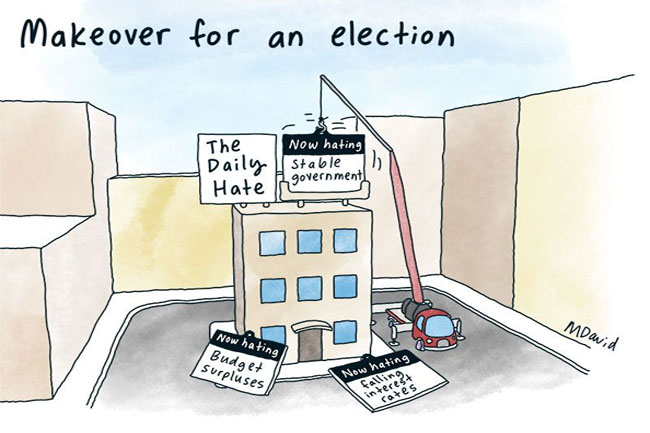Wage rises are running at the lowest rate in Australia since records have been kept. Alan Austin dissects the dismal data.
IT IS A QUESTION of priorities. How much of the nation’s vast wealth should go to rich Australian executives, how much to multinational corporations, how much to foreign governments, how much to welfare recipients and how much to local workers?
Workers’ wages rose in Australia by 1.36% over the year to September 2020. This is by far the lowest annual rate of increase for any 12-month period since the Australian Bureau of Statistics (ABS) began this series in 1997.
The second-lowest was 1.88% in the year to September 2016 after two of Australia’s three worst treasurers, Joe Hockey and Scott Morrison, had been trying to manage the economy for three years. See green chart, below.
The average annual rise over the 13 years before this Coalition regime took office is 3.64%. The long term average, going back to 1997, is 3.11%. (Figures are from ABS series 6345.0, table 1.)
With inflation running at 0.69%, this represents a real wage increase of a miserable 0.67% over the year.
We know the population the ABS monitors includes high-income salary earners who are reaping huge increases, notably in the finance and banking sectors. It is thus certain that many low-income earners – probably the vast majority – have experienced substantial real wage cuts.
This wage data adds to the long list of economic outcomes which were among the developed world’s best before this Coalition Government took office in 2013, but which are now among the worst.
Global comparisons
Tradingeconomics.com has data on wage growth for 27 developed countries and the European Union, current to August 2020 or later. The average rise through 2020 after allowing for inflation was a creditable 2.65%. See blue chart, below.
The real wage rise in Britain was 2.0%, in Europe 2.2%, in Ireland 4.9%, in Canada 5.2% and in Hungary 5.8%. All these improved their outcomes over the year earlier.
The increase in this developed-country average over the last year – from 2.27% in 2019 to 2.65% – confirms global conditions have been positive for wage increases, despite the coronavirus pandemic.
Australia, however, reduced its real wage rise, from 0.82% in 2019 down to 0.67% in 2020 — one of a small minority to do so.
This adds to the evidence that the big corporations and the Morrison Government are taking advantage of the pandemic to advance their campaign to shift wealth and income from Australian workers to their executives and investors, local and foreign.
The Government as employer
The biggest employers in Australia today are federal and state governments. Just in the last six years, 532,800 new public service jobs have been added.
The latest ABS data (file 6291, table 26a) shows governments now employ 1,975,300 people, which is 15.30% of all workers. That’s up from just 1,442,500 when this series began in 2014, an increase of almost 37%. That is an addition to the total workforce of 4.13%. See silver chart, below.
Hence with wages declining in real terms for the majority of workers, governments also save money which they can then allocate elsewhere.
Damage to Australia’s economy
Naturally, many employers are jubilant that workers’ salaries keep being cut. The multinational media companies, miners, exporters and others – who are the Coalition’s main beneficiaries – want to maximise profits for their shareholders and salaries and bonuses for their executives. So the lower their wages bill, the better.
But this is disastrous for Australia. It is one of the primary reasons Australia’s economy overall has fallen from being clearly the best-performed in the world from 2009 to 2013 to ranking around 19th today. When workers’ disposable income is reduced, the retail and hospitality sectors suffer immediately. This soon flows through to wholesalers, importers, manufacturers, agricultural producers, transport, service providers and others.
There is much the Federal Government could do to restore wages and thereby boost the domestic economy. It has significant input into penalty rates and the Fair Work Commission’s wage decisions. It sets most of its own employees’ salaries. And as colleague Dr Sabrin Farooqui has shown, wage theft remains an entrenched problem which governments are failing to fix.
Damage to Australia’s society
There is no excuse for Australia to be lagging the rest of the developed world so badly on workers’ remuneration.
Australia’s export sector is booming with iron ore prices at nine-year highs, volumes at new records, gold prices fluctuating around all-time highs, strong demand for Australian wool and excellent prices and volumes for many other commodities.
The trade surplus has been above $5 billion for the last three months and has averaged a thumping $5.88 billion for the last 12 months — the highest year ever.
So it comes down to priorities. If Irish workers can get a 4.9% pay lift and Canadians 5.2%, then Australians can do better than 0.67%. Unfortunately, the wellbeing of Australia’s workers and the health of the domestic economy are dismally low on the list of priorities of the Morrison Government.
Alan Austin’s defamation matter is nearly over. You can read the latest update here and help out by contributing to the crowd-funding campaign HERE. Alan Austin is an Independent Australia columnist and freelance journalist. You can follow him on Twitter @AlanAustin001.
Related Articles
- No favourable economic winds for Morrison's Australia
- No, Australia’s economy is not rebounding strongly. Who told you that?
- Company profits soar and wages fall while the media continues to mislead
- Australia’s economy collapses further as tax evasion whacks revenue
- World’s best economy in an age of COVID-19 — Taiwan tops the table
 This work is licensed under a Creative Commons Attribution-NonCommercial-NoDerivs 3.0 Australia License
This work is licensed under a Creative Commons Attribution-NonCommercial-NoDerivs 3.0 Australia License
Support independent journalism Subscribe to IA.












